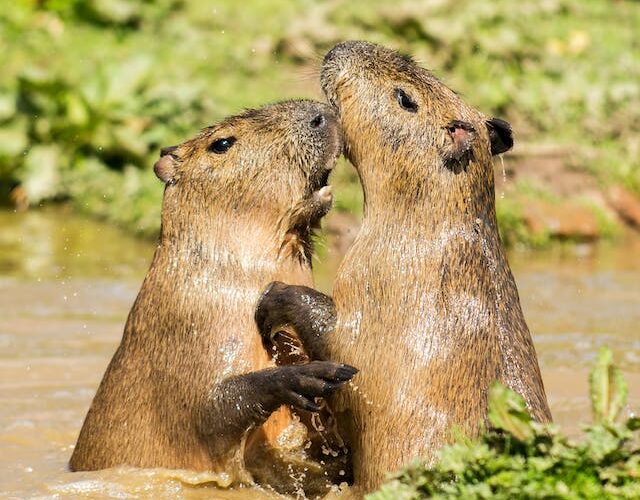In 1948, Idaho, a state in the United States, executed a unique relocation program by parachuting 76 beavers into the wilderness.
This initiative was aimed at mitigating the increasing conflicts between humans and beavers in areas like Payette Lake, where the animals’ natural behaviors posed challenges for new human residents.
The relocation site, Chamberlain Basin, was selected for its remote nature, providing an ideal environment for the beavers to thrive.
However, due to the absence of roads, the area’s inaccessibility led to an innovative solution – repurposing surplus parachutes from World War II to airdrop the beavers into their new habitat. A specially designed crate ensured the safety of the beavers during the drop.
The impact of this unconventional relocation was remarkable, as the beavers played a crucial role in transforming the landscape into a vibrant wetland.
The wetland provided a refuge against wildfire and drought and created one of the most extensive protected forests in the continental United States, where their descendants of parachuted beavers now reside.
So, how were Beavers able to transform the environment?
They make giant structures made of sticks, stones, and mud that can reach heights up to 10 feet, which act as a dam and play a significant part in their lives and the natural ecosystem. Their dam-building activities create wetlands that support diverse plant and animal life, contributing to the overall health and resilience of the ecosystem.
Before we understand the advantages of the dams that beavers build, let us know some facts about Beavers.
Facts about Beavers
Beavers are the second-largest rodent in the world after the capybara. They typically weigh between 15 to 30 kg. They are mostly found in freshwater habitats such as rivers, streams, ponds, and lakes across North America, Europe, and Asia.
One of the most distinctive features of beavers is their large, flat, scaly tail. The tail is used for various purposes, including steering while swimming and sounding alerts. They create a distinctive slapping sound on the water’s surface. This tail-slapping behavior is a warning signal to alert other beavers near potential threats, such as approaching predators.
Beavers have specialized abilities to close their nostrils and ears while submerged. This adaptation allows them to remain submerged for up to 15 minutes.
Beavers are herbivores with a diet primarily consisting of bark, twigs, leaves, and aquatic plants. To help them feed on their food, beavers possess powerful, continually growing, self-sharpening incisors. These incisors are used for grinding on wood, which is their primary food source. They can even cut trees with their powerful incisors. The constant gnawing helps regulate the length of their teeth.
Beavers tend to form monogamous pairs, establishing lifelong mating relationships. Both males and females actively raise their offspring, known as kits. Beavers often inhabit colonies, collaborating to build and maintain dams and lodges. A typical colony includes an adult pair, their offspring from the current and previous years, and sometimes older siblings.
To construct these lodges, beavers use sticks, logs, and mud. These burrows serve multiple purposes, such as providing a secure living space for the beaver family, offering them protection, facilitating food storage during winter, and providing a safe environment for raising their children.
In addition, beavers use the same engineering skills to make dam-like structures, which partially block the water flow of rivers, which, in turn, create ponds that help them protect against predators. The dams can be quite large and complex, which allows the slow movement of water. However, these dams just don’t protect the beavers they significantly impact the natural ecosystems.
Why Beavers are Important in the Environment
Here are some reasons why the work of beavers is considered important for the environment:
Water Regulation:
Beavers build dams across rivers and streams, creating ponds. These structures help regulate water flow by slowing down the movement of water. This can be beneficial in preventing downstream flooding during heavy rains and ensuring a more consistent water supply during dry periods.
In addition, the water ponds act as natural filters, trapping sediments and pollutants and improving water quality downstream by reducing sedimentation and nutrient runoff.
Biodiversity Support:
The wetland habitats created by beavers support a rich biodiversity. They attract a variety of species, including insects, fish, amphibians, and waterfowl, which, in turn, can attract larger predators. This increased biodiversity contributes to the overall health and resilience of the ecosystem.
Beaver dams and ponds create new habitats for various plant and animal species. Wetlands formed by beaver activity support diverse ecosystems, providing breeding grounds for amphibians, waterfowl, and other aquatic life.
Erosion Control:
Beaver dams and the resulting ponds help control soil erosion by stabilizing stream banks. The slowed water flow and vegetation in and around beaver ponds reduce the erosion risk, protecting the landscape from degradation.
Climate Change Mitigation:
Wetlands created by beavers store carbon, helping mitigate the effects of climate change. The accumulated organic material in beaver ponds sequesters carbon, acting as a carbon sink and contributing to reducing greenhouse gas emissions.
Drought Resistance:
Beaver ponds can serve as reservoirs during dry periods, helping maintain water availability for longer. This can be especially important in mitigating drought’s impacts on aquatic and terrestrial ecosystems.
Reduce Wildfires:
The wetlands made by beaver dams moisturize the landscape, making it harder for wildfires to spread. In research done in the forests of the western USA, it was observed that during wildfires, the area of vegetation density loss in beaver habitats was approximately three times smaller than in areas without beavers.
Educational Value:
Studying beavers and their activities provides valuable insights into ecosystem dynamics, water management, and the interconnectedness of species. This knowledge is crucial for conservation efforts and sustainable environmental management.
Wrapping Up
Beavers are essential for the environment due to their significant ecological roles through their behavior and habitat modifications, making them one of the keystone species in our ecosystem.
While beavers can sometimes be considered nuisances due to their impact on human infrastructure, understanding and managing their presence can help balance the benefits they bring to ecosystems with potential conflicts with human activities.
Therefore, humans must find ways to coexist with beavers and appreciate their positive environmental contributions.
Here is a short video giving us some facts and why Beavers are essential in the environment.






Add comment